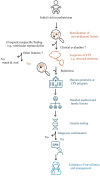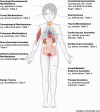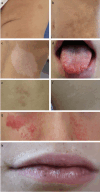Non-malignant features of cancer predisposition syndromes manifesting in childhood and adolescence: a guide for the general pediatrician
- PMID: 39641826
- PMCID: PMC11885337
- DOI: 10.1007/s12519-024-00853-8
Non-malignant features of cancer predisposition syndromes manifesting in childhood and adolescence: a guide for the general pediatrician
Abstract
Purpose: Cancer predisposition syndromes are genetic disorders that significantly raise the risk of developing malignancies. Although the malignant manifestations of cancer predisposition syndromes are well-studied, recognizing their non-malignant features is crucial for early diagnosis, especially in children and adolescents.
Methods: A comprehensive literature search was conducted using the PubMed database, focusing on non-malignant manifestations of cancer predisposition syndromes in children and adolescents. Key sources included the Clinical Cancer Research pediatric oncology series and ORPHANET. Studies that described clinical signs and symptoms affecting specific organ systems were included.
Results: Non-malignant dermatological features often serve as early indicators of cancer predisposition syndromes, including café-au-lait spots in Neurofibromatosis Type 1 and facial angiofibromas in Tuberous Sclerosis Complex. Neurological and developmental anomalies such as cerebellar ataxia in ataxia-telangiectasia and intellectual disabilities in neurofibromatosis type 1 and tuberous sclerosis complex are significant indicators. Growth and metabolic anomalies are also notable, including overgrowth in Beckwith-Wiedemann syndrome and growth hormone deficiency in neurofibromatosis Type 1. In addition, facial anomalies, ocular manifestations, hearing issues, and thyroid anomalies are prevalent across various cancer predisposition syndromes. For instance, hearing loss may be significant in neurofibromatosis Type 2, while thyroid nodules are common in PTEN hamartoma tumor syndrome and DICER1 syndrome. Cardiovascular, abdominal, musculoskeletal, pulmonary, genitourinary manifestations, and prenatal deviations further complicate the clinical picture.
Conclusions: Recognizing non-malignant features of cancer predisposition syndromes is essential for early diagnosis and management. This organ-specific overview furthers awareness among healthcare providers, facilitating timely genetic counseling, surveillance programs, and preventive measures, ultimately improving patient outcomes.
Keywords: Cancer predisposition; Children; Non-malignant manifestations; Psychosocial needs; Surveillance.
© 2024. The Author(s).
Conflict of interest statement
Declaration. Conflict of interest: No financial or non-financial benefits have been received or will be received from any party related directly or indirectly to the subject of this article. Ethical approval: Informed consent was obtained from the patients for scientific usage of the material.
Figures



References
-
- Ripperger T, Bielack SS, Borkhardt A, Brecht IB, Burkhardt B, Calaminus G, et al. Childhood cancer predisposition syndromes-a concise review and recommendations by the cancer predisposition working group of the society for pediatric oncology and hematology. Am J Med Genet A. 2017;173:1017–37. - PubMed
-
- Schiffman JD, Geller JI, Mundt E, Means A, Means L, Means V. Update on pediatric cancer predisposition syndromes. Pediatr Blood Cancer. 2013;60:1247–52. - PubMed
-
- Kratz CP, Jongmans MC, Cave H, Wimmer K, Behjati S, Guerrini-Rousseau L, et al. Predisposition to cancer in children and adolescents. Lancet Child Adolesc Health. 2021;5:142–54. - PubMed
-
- Nakano Y, Rabinowicz R, Malkin D. Genetic predisposition to cancers in children and adolescents. Curr Opin Pediatr. 2023;35:55–62. - PubMed
Publication types
MeSH terms
Grants and funding
LinkOut - more resources
Full Text Sources
Research Materials

